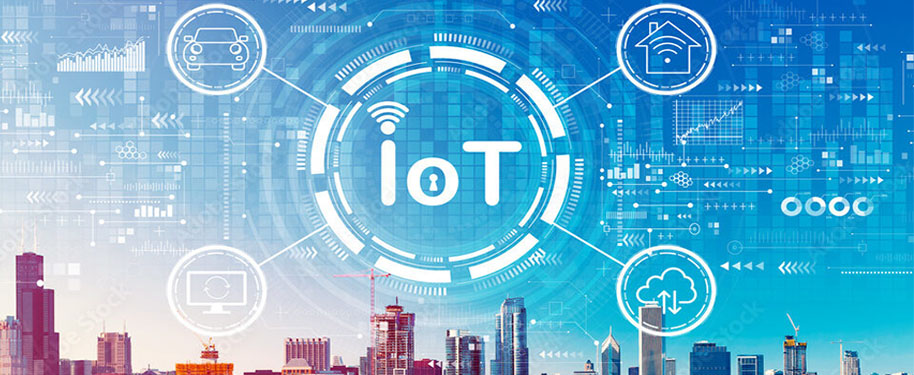-
Table of Contents
Exploring the future of connectivity and innovation.
The Internet of Things (IoT) is a rapidly growing network of interconnected devices that communicate and share data with each other. This technology has the potential to revolutionize various industries, from smart cities to connected healthcare. In this article, we will explore some of the latest trends in IoT and how they are shaping the future of these sectors.
The Impact of IoT on Smart Cities: Enhancing Efficiency and Sustainability
The Internet of Things (IoT) has revolutionized the way we live and interact with our surroundings. From smart homes to connected cars, IoT has become an integral part of our daily lives. One area where IoT has made a significant impact is in the development of smart cities. By leveraging IoT technologies, cities around the world are becoming more efficient, sustainable, and livable.
One of the key benefits of IoT in smart cities is the enhancement of efficiency. With IoT devices and sensors embedded in various infrastructure and public services, cities can collect and analyze real-time data to optimize resource allocation and improve operational efficiency. For example, smart traffic management systems can monitor traffic flow and adjust signal timings accordingly, reducing congestion and improving overall traffic flow. Waste management systems can also benefit from IoT, as sensors can detect fill levels in trash bins and optimize collection routes, reducing costs and minimizing environmental impact.
In addition to efficiency, IoT also plays a crucial role in promoting sustainability in smart cities. By monitoring and controlling energy consumption, cities can reduce their carbon footprint and contribute to a greener future. Smart grids, for instance, enable the integration of renewable energy sources and allow for better management of energy distribution. IoT devices can also be used to monitor air quality, water usage, and waste generation, providing valuable insights for environmental planning and policy-making.
Furthermore, IoT has the potential to enhance the quality of life for city dwellers. Smart city initiatives often focus on improving public services and infrastructure to create a more livable environment. For instance, IoT-enabled street lighting systems can adjust brightness levels based on real-time conditions, saving energy and improving safety. Smart parking systems can guide drivers to available parking spaces, reducing congestion and frustration. Public transportation can also benefit from IoT, with real-time tracking and scheduling systems improving reliability and convenience for commuters.
However, the implementation of IoT in smart cities is not without challenges. One of the main concerns is data security and privacy. With a vast amount of data being collected and transmitted, there is a need for robust cybersecurity measures to protect sensitive information. Additionally, the interoperability of different IoT devices and systems remains a challenge, as standardization is crucial for seamless integration and communication.
Looking ahead, the future of IoT in smart cities is promising. As technology continues to advance, cities will become even smarter and more connected. The integration of artificial intelligence and machine learning will enable cities to make data-driven decisions and automate processes, further enhancing efficiency and sustainability. Moreover, the emergence of 5G networks will provide faster and more reliable connectivity, enabling the deployment of more IoT devices and applications.
In conclusion, IoT has had a profound impact on smart cities, enhancing efficiency, sustainability, and livability. By leveraging IoT technologies, cities can optimize resource allocation, reduce their carbon footprint, and improve public services. However, challenges such as data security and interoperability need to be addressed for the full potential of IoT in smart cities to be realized. With continued advancements in technology, the future of IoT in smart cities looks promising, paving the way for a more connected and sustainable urban environment.
IoT in Healthcare: Revolutionizing Patient Care and Remote Monitoring
The Internet of Things (IoT) has revolutionized various industries, and healthcare is no exception. With the increasing adoption of IoT devices, patient care and remote monitoring have been transformed, leading to improved outcomes and enhanced efficiency in healthcare systems.
One of the key benefits of IoT in healthcare is the ability to remotely monitor patients. Traditionally, patients had to visit healthcare facilities for routine check-ups or to monitor chronic conditions. However, with IoT devices, patients can now be monitored from the comfort of their own homes. These devices, such as wearable sensors or smart implants, collect real-time data on vital signs, medication adherence, and other relevant health parameters. This data is then transmitted to healthcare providers, who can monitor patients remotely and intervene if necessary. This not only reduces the burden on healthcare facilities but also allows patients to receive personalized care without the need for frequent hospital visits.
IoT devices also enable continuous monitoring of patients with chronic conditions. For example, individuals with diabetes can use IoT-enabled glucose monitors that automatically transmit blood sugar levels to their healthcare providers. This allows for timely adjustments in medication or lifestyle changes, preventing complications and improving overall management of the condition. Similarly, patients with heart conditions can benefit from IoT-enabled cardiac monitors that detect abnormal heart rhythms and alert healthcare providers in real-time. By providing early intervention, IoT devices can significantly reduce the risk of adverse events and improve patient outcomes.
In addition to remote monitoring, IoT devices are also transforming patient care within healthcare facilities. For instance, IoT-enabled smart beds can monitor patients’ movements and automatically adjust the bed’s position to prevent pressure ulcers. This not only improves patient comfort but also reduces the risk of complications and the need for additional interventions. Similarly, IoT devices can be used to track the location of medical equipment within hospitals, ensuring that they are readily available when needed. This streamlines workflow and reduces the time spent searching for equipment, ultimately improving the efficiency of healthcare delivery.
Furthermore, IoT devices are facilitating the integration of healthcare systems and improving communication between healthcare providers. For example, electronic health records (EHRs) can be accessed and updated in real-time, allowing for seamless sharing of patient information across different healthcare settings. This ensures that healthcare providers have access to the most up-to-date information, leading to better coordination of care and reduced medical errors. Additionally, IoT devices can enable secure communication between healthcare professionals, allowing for timely collaboration and decision-making.
However, the widespread adoption of IoT in healthcare also raises concerns regarding data privacy and security. As IoT devices collect and transmit sensitive patient information, it is crucial to ensure that appropriate safeguards are in place to protect patient privacy. Healthcare organizations must implement robust security measures, such as encryption and authentication protocols, to prevent unauthorized access to patient data. Additionally, healthcare providers should educate patients about the potential risks and benefits of using IoT devices, empowering them to make informed decisions about their healthcare.
In conclusion, IoT has revolutionized patient care and remote monitoring in healthcare. From continuous monitoring of vital signs to improving communication between healthcare providers, IoT devices have the potential to enhance efficiency and improve patient outcomes. However, it is essential to address concerns regarding data privacy and security to fully harness the benefits of IoT in healthcare. With continued advancements in technology and increased collaboration between healthcare and technology sectors, the future of IoT in healthcare looks promising.
Security Challenges in the IoT Era: Safeguarding Data and Privacy
The Internet of Things (IoT) has revolutionized the way we live and work, connecting everyday objects to the internet and enabling them to communicate with each other. From smart cities to connected healthcare, the IoT has the potential to transform various industries and improve our quality of life. However, with this increased connectivity comes security challenges that must be addressed to safeguard data and privacy.
One of the main security challenges in the IoT era is the sheer number of devices connected to the internet. With billions of devices expected to be connected in the coming years, the attack surface for hackers and cybercriminals is expanding exponentially. Each connected device represents a potential entry point for malicious actors to gain unauthorized access to sensitive data or disrupt critical systems.
Another challenge is the diversity of IoT devices and their varying levels of security. Many IoT devices are designed with convenience and cost in mind, often sacrificing robust security measures. This makes them vulnerable to attacks and compromises the overall security of the IoT ecosystem. Additionally, the lifespan of IoT devices can be significantly longer than traditional IT devices, meaning that security vulnerabilities may persist for years without being addressed.
Furthermore, the vast amount of data generated by IoT devices poses a significant privacy concern. These devices collect and transmit a wealth of personal and sensitive information, such as health data in connected healthcare systems or location data in smart cities. If this data falls into the wrong hands, it can be used for malicious purposes, leading to identity theft, fraud, or even physical harm.
To address these security challenges, a multi-layered approach is necessary. First and foremost, manufacturers must prioritize security in the design and development of IoT devices. This includes implementing strong authentication mechanisms, encryption protocols, and regular security updates to patch vulnerabilities. Additionally, industry-wide standards and regulations should be established to ensure a baseline level of security across all IoT devices.
Network security is also crucial in the IoT era. Organizations must implement robust firewalls, intrusion detection systems, and secure communication protocols to protect the data transmitted between IoT devices and backend systems. Regular security audits and vulnerability assessments should be conducted to identify and mitigate any weaknesses in the network infrastructure.
Furthermore, data encryption and anonymization techniques should be employed to protect the privacy of IoT-generated data. By encrypting data at rest and in transit, organizations can ensure that even if it is intercepted, it remains unreadable to unauthorized individuals. Anonymization techniques, such as removing personally identifiable information, can further protect the privacy of individuals while still allowing for valuable insights to be derived from the data.
Lastly, user awareness and education play a crucial role in mitigating security risks in the IoT era. Users must be educated about the potential risks associated with IoT devices and how to protect themselves. This includes practicing good password hygiene, regularly updating device firmware, and being cautious of suspicious emails or messages that may be phishing attempts.
In conclusion, while the IoT brings numerous benefits and opportunities, it also presents significant security challenges. Safeguarding data and privacy in the IoT era requires a comprehensive approach that encompasses device security, network security, data encryption, and user education. By addressing these challenges head-on, we can fully harness the potential of the IoT while ensuring the safety and privacy of individuals and organizations alike.In conclusion, the Internet of Things (IoT) is rapidly transforming various industries, from smart cities to connected healthcare. The adoption of IoT technologies is increasing, enabling cities to become more efficient and sustainable while improving the quality of life for their residents. In the healthcare sector, IoT devices and applications are revolutionizing patient care, remote monitoring, and disease management. As IoT continues to evolve, it is expected to bring about significant advancements and opportunities in various sectors, making our lives more connected and convenient.





